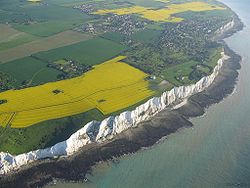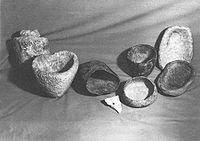Chalk
Chalks many uses over the past centuries, have proved its durability and strength. Originally formed from calcium carbonate, chalk has been altered over the years to fit the needs of those all across the world. It uses are limitless. Teachers use the product in classrooms to help teach their students on blackboards, while construction workers use it to aid in the construction of buildings. Also, chalk has been placed in the spotlight due to controversy over its main component, calcium carbonate. This natural substance, seen in its entirety and beauty in the White Cliffs of Dover, has been a main arguing point for many evolutionists. They believe the cliffs were formed over millions of years. However, Christian geologists have evidence to support their belief that the build up only took place over a few thousand years. Overall, the beauty of these White Cliffs and the intricacy and development of chalk only further displays God mighty hand at work in the universe.
History
Originally, chalk was created and formed from natural resources, generally those in the earth. These “natural chalks” were available only until the early nineteenth century, before being replaced with modern synthetic counterparts. Artist Giogio Vasari commented on the quality condition of chalk saying it must be, “soft enough to be easily sawn and reduced to a fine point suitable for marking on leaves of paper.” Vasari made these comments in 1550 when chalk was constricted to the colors red, black, and white. The lack of a variety of colors and types only further proved the quality of the materials needed to make chalk. The chalk had to be very dense and produce an even color. The black chalk, composed of soft carbonaceous schist, also contained carbon and clay. In 1390, artist Cennino Cennini recording the following discovery in one of his manuals: “Also for drawing, I have come across a certain black stone, which comes from Piedmont; this is a soft stone and it can be sharpened with a penknife. It is very black. And you can bring it to the same perfection as charcoal. And you can draw as you want to.” According to Vasari, the black chalk was found in the hills of France in the 16th century. It was available throughout Europe, but as stocks ran out, this older version was replaced by graphite and fabricated chalks.[1]
Natural red chalk, or sanguine, has been around for thousands of years, first being used by the ancient Egyptians and Romans. They used the dry earth pigment to write on walls, but the chalk did not become as popular as the black one until the 16th century. It receives its rich color from a red ochre variety of hematite, although the color varies greatly upon the quality and origin of the ochre. Leonardo da Vinci first used the chalk in his paintings capturing the attention of other artists who soon after, began using the chalk as well..[1]
Finally, the most popular chalk color, white, originated thousands of years ago. there are two distinct types of white chalk, calcite or calcium carbonate, and soapstone or steatite. These differ in that one is a soft bright white, while the other is a harder more bluish-white tone. As technology began to heighten, the use of natural chalk declined. Synthetic black chalks could be acquired as early as the 17th century, made from carbon and a binder. People also found the quality of the sticks of chalk a nuisance seeing as they wore out quite quickly. Researchers soon developed manufactured chalk crayons, which consisted of combining colored pastes with some type of water-soluble binding substance such as glue. These new chalks offered a wide array of colors and levels of softness as opposed to the natural methods earlier used.[1]
Formation
Chalk can be formed in many various ways. It is a fossilized deposit of earth materials. Calcium carbonate, for example, can be found in caves and in the earth’s crust. England, Dover, and Kent contain large amounts of coccoliths, or calcium carbonate scales. [2]Chalk itself, is a very porous fine-textured substance. As previously mentioned, its main component, calcium carbonate, is composed of many various micro organisms. These billions of organisms include foraminifera and the shells of calcareous algae. This algae is known more commonly as coccolith and rhabdolith. Creationists and geologists believe that the present holds the key to how chalk is currently made. They study the accumulation of the algae and the type in order to make further conclusions about the formation of chalk. Seeming’s as calcium carbonate covers such a vast amount of the earth’s oceans, there has been much controversy from creationists and evolutions on this matter. Creationists stand firm to the flood theory which suggests that the oozes producing the calcium carbonate at the bottom of the oceans, could very well have been produced in as little as one thousand years. The famous White Cliffs of Dover only further support the creationist’s ideas. [3]
When humans first began using chalk they combined natural chalk which had been ground into a fine powder with water or another type of binder. Next, the mixture would be dried and placed into a mold shaping it into a cylinder or stick shape. To enhance color, artists added pigments to create bright vivid shades. Carbon would be added in order to enhance black, while ferric oxide created a more intense red.[4]
Synthesis
Nowadays, classroom chalk is typically made of gypsum, more specifically hydrated calcium sulfate. No longer do chalk makers depend on mined calcium carbonate. [5] This synthesized substance can be seen in classrooms across the world, and serves as a cheaper means than acquiring actual calcium carbonate. Makers have the capability of forming either small or large sticks in various colors.
Uses
Other than the commonly known uses, chalk has many benefits and practical functions. First, builders and contractors often use chalk to make lime, quicklime, cement, putty, plaster, and mortar. Chalk alone, can be very hard for builders to use due to its resistance to water, therefore, they combine the powder with other binders to create a more usealble substance. [6] In the past, chalk has aiding teachers in teaching their students. The common blackboard was a place where teachers could write in front of their class and present new ideas to students in a clear accurate manner. However, as researchers further studied chalk, and more specifically student health, they discovered its negative affects within the classroom. Due to the many dust particles and nasal hazards, chalk has been removed from many classrooms. Yet many schools around the world still use this commodity due to its cheap cost and benefits.
Dangers
In recent years, a large push has been made to eliminate the use of chalk and chalk boards. Rather, schools and facilities strongly suggest the use of white boards and dry erase markers. Critics argue that three main problems justify the banning of chalk.
- It can cause allergic reactions as the particles stay in the air and interfere with children and teachers
- Chalk dust can have many negative affects upon electronics such as computers and projectors
- Chalk can also pose as inconvenient as it often breaks and is hard to clean up
Overall, researchers have found that the chalk particles released into the atmosphere can potentially travel hundreds of feet and obstruct people as well as objects. The Academy of Allergy and Immunology issued a statement after their study saying, “Chalk dust, “is an irritant that can trigger an asthma attack, and students who have allergies to dust particles or who have asthma should stay away from chalk boards and erasers.” A survey in 1998 found that nearly 5 million children in the United States suffer from Asthma, missing about 10 million school days per year. However, when proper prevention is taken, Asthma and its effects can be greatly reduced. [7]
References
- ↑ 1.0 1.1 1.2 Chalk Jan Mari Maniego, Accessed 5/4/11
- ↑ Facts about Chalk Author Unknown, Accessed 5/5/11
- ↑ Can flood geology explain think chalk beds? Andrew A. Snelling First published:TJ 8(1):11–15 April 1994
- ↑ Chalk: How Products are Made Author Unknown, Accessed 5/16/11
- ↑ Chalk Author Unknown, Accessed 5/22/11
- ↑ The Origin of Chalk Author Unknown, Accessed 5/5/11
- ↑ Troy DRYMark Author Unknown, Accessed 5/5/11
| ||||||||||||||




